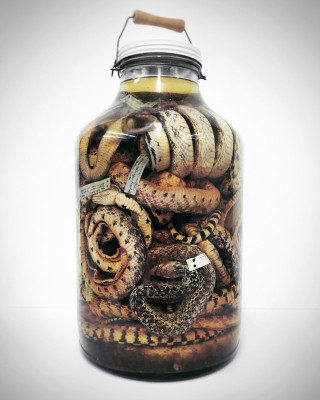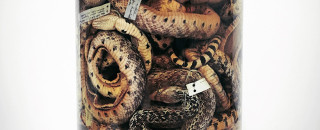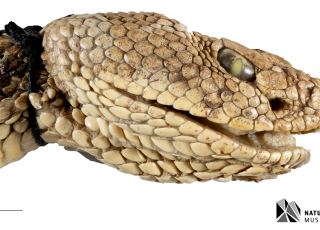Jar of Snakes
By Eric Rickart, Ph.D.
This jar contains several specimens of the common western gopher snake (Pituophis catenifer). This species is a non-venomous snake common throughout the central and western U.S. Although harmless, they mimic the behavior of rattlesnakes, coiling, shaking their tails, and even "striking" to falsely warn potential predators. These snakes were collected in Utah and surrounding states in the 1920's and '30's, and include some of the oldest specimens in our reptile collection.

© NHMU, photo by Tim Lee. Click on image to enlarge.
They are fluid-preserved specimens, also referred to as wet specimens or "alcoholics" (that is to say preserved in alcohol, not dipsomaniacs!). The oldest specimens may have been preserved by placing the dead animal directly in alcohol (ethanol), but most were first "fixed" in formalin for a period of time and afterwards stored in 70% ethanol. Formalin is a solution of the gas formaldehyde and it is the main ingredient of embalming fluid used by undertakers.
Because formalin "fixes" or hardens the tissues of the body, it preserves the organ structure so that the anatomy of the specimen can be studied - this is the principal advantage of preserving specimens in this manner. Unfortunately, formalin chemically changes DNA, so "fixed" specimens can't be use for genetic work (at least not until someone devises a method for reversing these changes). The older specimens that were not fixed in formalin are less useful for anatomical studies, but are valuable because their DNA is intact.

Eric Rickart, Ph.D. is the Curator of Vertebrate Zoology for the Natural History Museum of Utah, an Adjunct Associate Professor in the Department of Biology at the University of Utah, and a Research Associate of the Field Museum, Chicago. NHMU's mission is to illuminate the natural world and the place of humans within it. In addition to housing outstanding exhibits for the public, NHMU is a research museum. Learn more.



